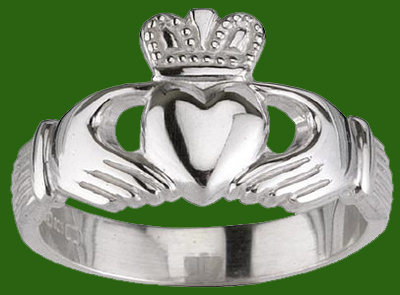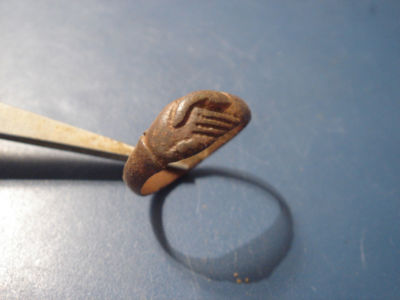You are currently browsing the tag archive for the ‘Ring’ tag.
Famous in love stories and movies, the Claddagh ring is a traditional Irish band with elements that go back to Roman times. The ring consists of two hands holding a crowned heart and dates back to the 17th century where the design originated in the village of Claddagh by Galway.
According to tradition, each element of the ring is symbolic. The hands stand for friendship, the heart stands for love, and the crown stands for loyalty. The position of the ring on the hands is also important: when the ring is on the right ring finger with the heart out, it means the wearer is single and seeking love (or some reasonable approximation); when the ring is on the right hand with the heart turned in, it means the wearer is in a relationship, but not engaged. When the Claddagh ring jumps to the left ring finger things have gotten serious: the Claddagh with the heart outward indicates betrothal and when heart is turned inward, the wearer is married. Or at least that is what people say about the tradition. Every ring I have worn ceaselessly turned like a record on my finger. I’m sure all sorts of couples would end up in desperate needless fights if the Claddagh tradition was held too closely.
Although the folklore traditions in the paragraph above seem to be innovations of the nineteenth century, the ring descends (through a long lineage) from Roman “fede” rings which featured clasped or joined hands as symbolic of a sacred vow.
Some artists sign their works with a symbol instead of with their written name. My favorite of all these artist’s symbols was the one employed by the great German gothic painter Lucas Cranach. Ferrebeekeeper has already written about Lucas Cranach’s troubling allegory Melancholy, his fascination with severed heads and femme fatales, and his magnificent depiction of animals. Cranach usually signed his works with a black winged serpent holding a ruby ring in its jaws and wearing a crown. It fills me with frustration that I didn’t think of it first—imagine signing the water bill with that!
There are various different versions of the serpent. Cranach changed it around—especially when he signed printed artworks. Elector Frederick the Wise granted the winged serpent with a crown and ruby ring to Cranach as a coat of arms on January 6th, 1508, but nobody is sure what it means. Some art historians have speculated that it is an astrological or alchemical symbol. Others believe it may be a lost pun concerning some aspect of Cranach’s name or have some allegorical meaning too subtle to fathom. The actual explanation seems lost in mystery (which is probably how Cranach would like it). Whenever I see a Cranach painting in a museum, the search for his serpent sigil is part of the fun.












